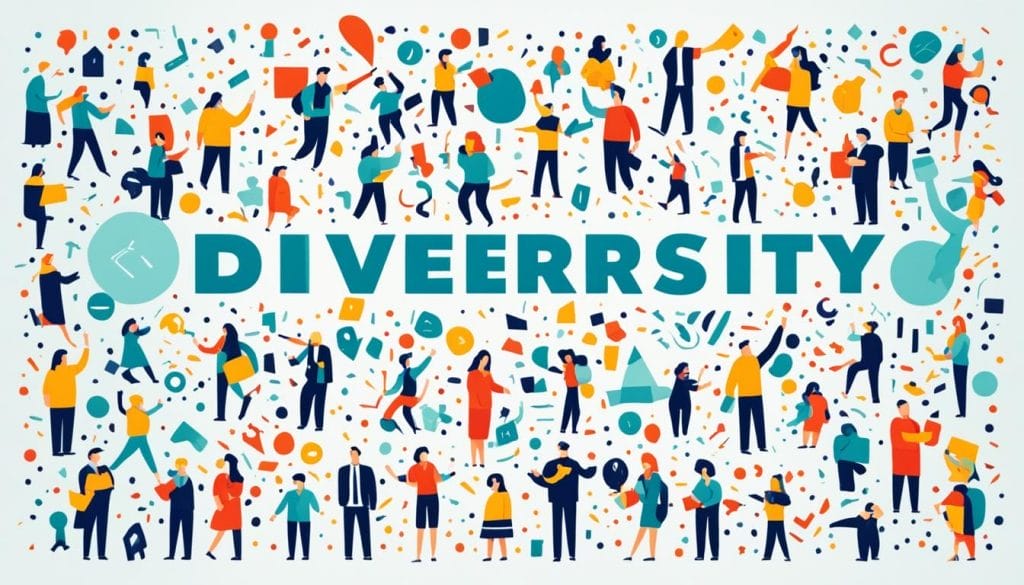Did you know that diversity training is offered by a majority of Fortune 500 companies? Yet, the impact of this training often remains unmeasured, leaving organizations uncertain about its effectiveness in fostering inclusive workplaces. In this article, we delve into the outcomes of diversity training and examine whether it truly leads to positive change in attitudes and behaviors.
Research conducted by experts reveals that while diversity training can have a positive effect on the attitudes of some employees, particularly those initially less supportive of women in the workplace, it may not significantly influence the behavior of men and White employees as a whole. This finding raises questions about the overall efficacy of diversity training programs and highlights the need for organizations to adopt a diversified approach to training and gather more data to improve their effectiveness.
Key Takeaways:
- Diversity training is widely offered but often lacks measurement of its impact.
- Some employees show positive attitude changes after bias training, but behavior change may be limited.
- Organizations should diversify training approaches and collect more data to improve effectiveness.
The Importance of Diversity Training
Diversity training plays a crucial role in creating inclusive workplaces and fostering a sense of belonging for all employees. While diversity training is widely offered by Fortune 500 companies, understanding its impact and effectiveness is paramount to achieving its desired outcomes. It is essential to explore the outcomes and benefits of diversity training to ensure its continued relevance and effectiveness.
Research has shown that diversity training can have unintended consequences if not implemented carefully. In some cases, it may elicit defensiveness from individuals who perceive themselves as its intended beneficiaries. Furthermore, the positive effects of diversity training may not always be sustained after the program ends, creating a need for ongoing evaluation and refinement.
By delving into the importance of diversity training, organizations can better understand its impact and make informed decisions about their training initiatives. It is crucial to recognize that diversity training, when thoughtfully designed and implemented, can help reduce bias and enhance understanding among employees from diverse backgrounds.
Diversity training can create a more inclusive work environment, where individuals are empowered to challenge biases and collaborate effectively with colleagues from different backgrounds.
Studies have shown that diversity training can broaden employee perspectives, increase empathy, and cultivate a culture of respect. It equips employees with essential skills to navigate diverse settings and embrace different viewpoints. Through diversity training, organizations can enhance their employees’ ability to work together, fostering teamwork and improved productivity.
It is equally important to recognize that the impact of diversity training may vary across different organizations and contexts. The success of diversity training programs depends on various factors, such as the design, delivery, and ongoing support provided to participants.
To gain further insights into the effectiveness of diversity training, it is valuable to examine research studies and resources from reputable sources. For instance, ScienceForWork offers valuable insights on the effectiveness of diversity training (ScienceForWork – Diversity Training Effectiveness).
Diversity Training Benefits
Diversity training offers a range of benefits that can contribute to the growth and success of organizations. By promoting understanding, inclusivity, and collaboration, diversity training creates a more harmonious and productive work environment.
One of the key advantages of diversity training is its ability to increase awareness and understanding of different perspectives. By exposing employees to diverse experiences, cultures, and ideas, the training helps break down biases and stereotypes. This leads to improved communication and empathy among team members, fostering a more inclusive and respectful workplace.
Reducing unconscious bias is another significant benefit of diversity training. Unconscious biases are ingrained stereotypes or prejudices that influence our perceptions and actions. Diversity training helps individuals identify their biases and provides tools and strategies to mitigate their impact. This leads to fairer decision-making processes and a more equitable work environment.
Furthermore, diversity training improves teamwork and collaboration. When employees have a better understanding of diverse perspectives, they can leverage the strengths and expertise of their colleagues from different backgrounds. This drives innovation, enhances problem-solving capabilities, and boosts overall team performance.
Employee morale, job satisfaction, and retention are also positively impacted by diversity training. When employees feel valued, respected, and included, they are more engaged and motivated. This fosters a positive work culture and reduces turnover, allowing organizations to retain top talent and benefit from their diverse skills and experiences.
To ensure that diversity training is effective and worthwhile, measuring the return on investment (ROI) is crucial. By evaluating the impact of diversity training on organizational performance, companies can determine if the training initiatives are generating tangible benefits. ROI measurement can include assessing changes in employee satisfaction, productivity, and diversity-related metrics.
| Benefits of Diversity Training | Explanation |
|---|---|
| Increased awareness and understanding of different perspectives | Acknowledging and appreciating diverse viewpoints leads to improved communication and empathy among team members. |
| Reduction of unconscious bias | Diversity training helps individuals recognize and minimize unconscious biases, leading to fairer decision-making and a more equitable work environment. |
| Improved teamwork and collaboration | Understanding diverse perspectives enables employees to leverage the strengths of their colleagues, driving innovation and enhancing overall team performance. |
| Enhanced employee morale, job satisfaction, and retention | When employees feel valued, respected, and included, they are more engaged and motivated, contributing to a positive work culture and reduced turnover. |
Diversity training has the potential to transform workplaces by fostering inclusivity, improving communication, and driving innovation. However, measuring the ROI of diversity training ensures that organizations can assess its impact and continuously improve their training initiatives.
Next, we will explore how organizations can evaluate the effectiveness of their diversity training programs.
Source: https://www.ncbi.nlm.nih.gov/pmc/articles/PMC8919430/
Evaluating Diversity Training Effectiveness
To ensure that diversity training programs are effective in promoting inclusivity and driving positive change within organizations, it is crucial to evaluate their outcomes and impact. Implementing evaluation measures allows organizations to gather data and analyze the results, providing valuable insights into the effectiveness of their diversity training initiatives.
There are several evaluation methods that can be employed to assess the effectiveness of diversity training:
- Surveys: Surveys are an effective way to gather feedback from employees who have completed diversity training programs. By asking targeted questions about their perceptions, attitudes, and behavior, organizations can gain valuable insights into the impact of the training.
- Pre- and post-training assessments: Conducting assessments before and after the training can help measure changes in knowledge, attitudes, and skills. This allows organizations to gauge the effectiveness of the training in addressing biases and fostering inclusive behaviors.
- Behavioral observations: Observing employee behavior in the workplace can provide valuable insights into the practical application of diversity training. By monitoring interactions, teamwork, and collaboration, organizations can assess if the training is translating into positive behavioral changes.
Through comprehensive evaluation, organizations can determine if their diversity training programs are achieving the desired outcomes and making a positive difference in the workforce. Evaluation serves as a critical tool for continuous improvement and refinement of diversity training initiatives.
“Effective evaluation allows organizations to measure the impact of diversity training, make informed decisions, and drive meaningful change.”
By analyzing evaluation data, organizations can identify areas of strength and areas that require improvement. This allows for targeted adjustments and enhancements to be made to the diversity training programs, maximizing their impact. Additionally, evaluation data provides organizations with evidence to communicate the effectiveness and value of their diversity training initiatives to stakeholders.
It is important to note that diversity training evaluation should not be a one-time event but rather an ongoing process. Regular evaluation enables organizations to continually assess the effectiveness of diversity training initiatives and adapt them to evolving needs and challenges.
Example Table: Diversity Training Evaluation Metrics
| Metrics | Description |
|---|---|
| Participant Satisfaction | Evaluating participants’ overall satisfaction with the diversity training program through post-training surveys or feedback forms. |
| Knowledge Gain | Assessing the increase in participants’ knowledge and understanding of diversity-related concepts through pre- and post-training assessments. |
| Attitude Change | Measuring shifts in participants’ attitudes and perceptions regarding diversity, equity, and inclusion through surveys or interviews. |
| Behavioral Change | Observing and tracking participants’ behaviors in the workplace to evaluate whether the training has positively influenced their actions and interactions. |
| Organizational Impact | Assessing the impact of diversity training on overall organizational culture, employee satisfaction, retention rates, and performance metrics. |
By utilizing a combination of evaluation methods and metrics, organizations can gather comprehensive data to inform decision-making and drive continuous improvement in their diversity training initiatives.
Best Practices for Diversity Training

To ensure the effectiveness of diversity training, organizations should implement best practices that align with their specific needs and goals. By following these practices, organizations can maximize the impact of their diversity training programs and create a more inclusive work environment.
Tailor the Training
Customize diversity training to address the unique challenges and opportunities within the organization. Consider the diversity of the workforce, industry-specific dynamics, and current workplace climate. Tailored training helps employees see the relevance and applicability of the content to their daily work.
Incorporate Interactive and Experiential Learning Methods
Engage participants actively in the learning process by incorporating interactive and experiential learning methods. This can include role-playing exercises, case studies, group discussions, and real-life scenarios. Interactive learning methods encourage active participation, reflection, and application of concepts.
Provide Ongoing Support and Reinforcement
Diversity training is not a one-time event but an ongoing process. Provide employees with continuous support and reinforcement to ensure long-term behavior change. This can include follow-up workshops, mentoring programs, coaching sessions, and inclusion resources.
Create a Safe and Inclusive Learning Environment
Establish a safe and inclusive learning environment where employees feel comfortable expressing themselves and sharing their perspectives. Encourage open dialogue, active listening, and respect for diverse viewpoints. Foster an atmosphere of psychological safety where individuals feel accepted and valued.
Involve Top Leadership and Managers
Leadership support is crucial for the success of diversity training initiatives. Involve top leadership and managers in the training to demonstrate commitment to diversity and inclusion. When leaders actively participate, employees are more likely to recognize the importance of diversity and embrace inclusive behaviors.
By following these best practices, organizations can enhance the effectiveness of their diversity training programs and create a more inclusive and diverse workforce.
The Role of DEIA Training
DEIA (Diversity, Equity, Inclusion, and Belonging) training plays a vital role in creating equitable and inclusive workplaces. This training goes beyond the surface-level understanding of diversity to address deeper issues such as power dynamics, privilege, and systemic barriers. By focusing on these aspects, DEIA training aims to foster a sense of belonging and empowerment among individuals.
DEIA training encourages participants to challenge biases and assumptions, promoting a more inclusive culture within organizations. It equips employees with the tools and knowledge to recognize and address structural inequalities that may exist. By doing so, DEIA training helps organizations create an environment where every employee feels valued and has equal opportunities for growth and success.
“DEIA training promotes a more inclusive culture within organizations.”
This training plays a complementary role to traditional diversity training by taking a holistic approach to diversity and inclusion. While diversity training focuses on raising awareness and understanding, DEIA training delves deeper into the systemic issues that underlie inequality in the workplace.
Organizations that prioritize DEIA training alongside traditional diversity training can benefit from a more comprehensive understanding of diversity and a stronger commitment to equitable practices. By embracing DEIA training, organizations demonstrate their dedication to dismantling barriers and creating a work environment that fosters equal opportunities for all.
For more information on DEIA training and its impact on fostering inclusive workplaces, please visit this resource.
Advantages of DEIA Training:
- Addresses power dynamics, privilege, and systemic barriers
- Fosters a sense of belonging and empowerment
- Challenges biases and assumptions
- Promotes a more inclusive culture
- Recognizes and addresses structural inequalities
Challenges in Diversity Training

Implementing diversity training can encounter various challenges that impact its effectiveness. Overcoming these obstacles is crucial to ensure the success of diversity training programs. Some common challenges in diversity training include:
- Resistance to change: Individuals may resist the ideas and concepts presented in diversity training due to ingrained beliefs or fear of the unknown.
- Difficulty in measuring outcomes: It can be challenging to evaluate the tangible impact of diversity training on employees’ attitudes, behaviors, and overall workplace culture, which may hinder the ability to assess its effectiveness.
- Lack of resources and support: Limited resources, such as time, budget, and dedicated staff, can impede the development and implementation of comprehensive diversity training programs.
- Potential for unintended negative consequences: Despite good intentions, diversity training can sometimes lead to unintended negative consequences, such as reinforcing stereotypes or triggering defensiveness among participants.
To ensure the success of diversity training initiatives, organizations must proactively address these challenges. Developing strategies to overcome resistance, employing robust evaluation methods, securing adequate resources, and carefully designing training content are essential steps to maximize the impact of diversity training programs.
Addressing Resistance to Change
When facing resistance to diversity training, organizations can implement the following strategies:
- Providing clear communication: Clearly communicate the goals, benefits, and importance of diversity training to address misconceptions and alleviate concerns.
- Creating a safe environment: Establish a non-judgmental and inclusive learning environment where participants feel comfortable expressing their thoughts and exploring different perspectives.
- Offering ongoing support: Provide ongoing support and opportunities for dialogue to reinforce the training and answer questions or concerns that may arise.
- Engaging leadership: Obtain buy-in and support from top-level executives to demonstrate the organization’s commitment to diversity.
Remember, addressing resistance to diversity training requires a comprehensive approach that involves communication, support, and leadership involvement.
By overcoming challenges and implementing effective strategies, organizations can optimize the outcomes of their diversity training programs, fostering an inclusive workplace that values and celebrates diversity.
Overcoming Diversity Training Challenges with Hyperspace DEIA Training
Hyperspace, a leader in diversity, equity, inclusion, and belonging (DEIA) training, offers a comprehensive program designed to address the challenges commonly faced in traditional diversity training initiatives. Their unique approach focuses on leveraging the power of diversity to drive innovation and growth within organizations while promoting equity, fairness, and inclusivity.
With Hyperspace’s DEIA training, organizations gain access to a range of tools and strategies that empower employees to overcome barriers and achieve positive outcomes in their diversity and inclusion initiatives. The program goes beyond surface-level awareness and fosters a deep understanding of unconscious biases, systemic barriers, and power dynamics that impact workplace relationships and opportunities.
Hyperspace’s DEIA training is designed to create an inclusive and supportive work environment where every employee feels valued, respected, and empowered to contribute their unique perspectives. The program equips participants with the knowledge and skills to challenge biases, navigate difficult conversations, and actively foster a sense of belonging for all individuals.
By embedding the principles of DEIA into the fabric of the organization, Hyperspace’s training enables lasting change and fosters a culture of inclusivity. Employees become advocates for diversity and make meaningful contributions to creating equitable workplaces that drive innovation, enhance collaboration, and attract top talent.
“Hyperspace’s DEIA training provided us with a transformative experience. It shifted our perspectives, challenged our assumptions, and empowered us to drive change within our organization.” – Sarah Thompson, Diversity and Inclusion Manager at ABC Corporation
Hyperspace’s DEIA training aligns with industry best practices and is continuously updated to address emerging challenges and trends in diversity and inclusion. The program draws on the latest research, insights, and case studies to provide cutting-edge content that resonates with participants and drives tangible results.
Key Benefits of Hyperspace’s DEIA Training:
- Promotes diversity as a catalyst for innovation and growth
- Develops skills to challenge biases and create inclusive environments
- Fosters a deep understanding of power dynamics and systemic barriers
- Equips employees with strategies for navigating difficult conversations
- Enhances collaboration, teamwork, and employee engagement
- Drives positive organizational change and cultural transformation
With Hyperspace’s DEIA training, organizations can overcome the challenges commonly associated with traditional diversity training programs and unlock the full potential of their diverse workforce. By investing in DEIA training, companies demonstrate their commitment to creating inclusive cultures that value diversity and empower individuals to thrive.
Explore the research conducted by Stanford University on the effectiveness of DEIA training in fostering inclusive workplaces.
The Science of Diversity Training

The effectiveness of diversity training is an area of ongoing research. While there is enthusiasm and monetary investment in diversity training, the available evidence on its effectiveness is limited. Researchers and practitioners need to work together to conduct rigorous and relevant studies to advance the science of diversity training. This includes utilizing clear goals, standardized measurements, and robust experimental designs to assess the impact of diversity training programs accurately.
Diversity training research plays a pivotal role in understanding the outcomes and effectiveness of these programs. By conducting well-designed studies, researchers can not only contribute to the growing body of knowledge but also provide evidence-based recommendations for organizations seeking to create more inclusive work environments.
“To understand the true impact and potential of diversity training, organizations need to invest in scientific research methods to measure its effectiveness accurately. By applying a scientific lens to diversity training, we can uncover new insights and refine our approaches to foster inclusivity and equality in the workplace.”
Clear goals are essential in determining the desired outcomes of diversity training programs. These goals should articulate the specific changes in attitudes, behaviors, and organizational culture that the training aims to achieve. By establishing clear goals, researchers can design studies that assess the extent to which these objectives are met.
Standardized measurements are crucial for evaluating the impact of diversity training consistently. Researchers should employ reliable and valid assessment tools to measure changes in individuals’ attitudes, behaviors, and perceptions of inclusivity. These measurements can provide valuable insights into the long-term effectiveness and sustainability of diversity training interventions.
Benefits of Research-Backed Diversity Training
Investing in research-backed diversity training programs offers several advantages. First, it ensures that organizations are adopting evidence-based practices proven to be effective in promoting diversity and inclusion. By relying on solid research findings, organizations can have confidence in the positive impacts their training initiatives will have on their workforce.
“Research-backed diversity training provides organizations with the knowledge and tools to create truly inclusive workplaces. By generating empirical evidence on what works and what doesn’t, research enables organizations to make data-driven decisions and maximize the impact of their diversity training initiatives.”
Second, research-backed diversity training can help organizations overcome skepticism and resistance from employees. When training programs are grounded in scientific evidence, employees are more likely to perceive them as credible and relevant. This, in turn, enhances engagement and participation, increasing the likelihood of positive outcomes.
The Role of Robust Experimental Designs
To accurately assess the impact of diversity training, researchers should employ robust experimental designs. Randomized controlled trials (RCTs) are considered the gold standard for evaluating the effectiveness of interventions, including diversity training. RCTs involve randomly assigning individuals or groups to either the training or control condition, allowing for rigorous comparisons between the two groups.
By using experimental designs, researchers can address potential confounding factors that could influence the effectiveness of diversity training. This includes controlling for pre-existing biases, individual characteristics, and external influences that could affect participants’ responses. The use of robust experimental designs strengthens the validity and reliability of research findings, providing organizations with more accurate insights into the outcomes of their diversity training programs.
| Key Elements for Advancing the Science of Diversity Training | Benefits |
|---|---|
| Clear goals | • Enables targeted evaluation\n• Guides program design\n• Identifies desired outcomes |
| Standardized measurements | • Provides consistent evaluation criteria\n• Allows for meaningful comparisons\n• Assesses long-term impact |
| Robust experimental designs | • Controls for confounding factors\n• Facilitates rigorous comparisons\n• Strengthens validity of findings |
Recommendations for Improving Diversity Training Effectiveness
Improving the effectiveness of diversity training requires organizations to implement evidence-based recommendations. By following these best practices, organizations can enhance the impact of their diversity and inclusion efforts.
1. Incorporate Interactive and Experiential Learning Methods
To make diversity training more engaging and impactful, organizations should incorporate interactive and experiential learning methods. This could include interactive exercises, role-playing scenarios, group discussions, and case studies. By actively involving participants in the learning process, diversity training becomes more memorable and fosters a deeper understanding of diverse perspectives.
2. Provide Ongoing Support and Reinforcement
Effective diversity training goes beyond a one-time event. Organizations should provide ongoing support and reinforcement to ensure the sustainability of training outcomes. This could include follow-up workshops, coaching sessions, mentoring programs, or employee resource groups. Continuously reinforcing diversity training concepts helps to cement new behaviors and ensure long-term impact.
3. Involve Top Leadership and Managers
For diversity training to be effective, it is crucial to have the involvement and support of top leadership and managers. When leaders actively participate in training initiatives, it signals a commitment to diversity and inclusion throughout the organization. Involving managers also ensures that they understand the importance of diversity, can lead by example, and reinforce training messages in day-to-day operations.
4. Address Structural Inequalities through DEIA Training
While diversity training focuses on individual attitudes and behaviors, organizations should also address structural inequalities through DEIA (Diversity, Equity, Inclusion, and Belonging) training. DEIA training examines the systemic barriers that perpetuate inequality in the workplace and provides strategies for creating a more equitable and inclusive environment. By tackling both individual and systemic issues, organizations can create lasting change and promote greater diversity and inclusion.
5. Continuously Evaluate and Refine
To ensure the ongoing effectiveness of diversity training, organizations must continuously evaluate and refine their initiatives. This includes collecting feedback from participants, conducting surveys, analyzing data, and measuring the impact of the training. By assessing the success of diversity training programs and making necessary adjustments, organizations can optimize their efforts and achieve better outcomes over time.
Implementing these recommendations will help organizations enhance the effectiveness of their diversity training programs. By adopting evidence-based practices, organizations can create a more inclusive and diverse workforce, fostering an environment where every individual feels valued and empowered.
Future Directions in Diversity Training Research
As organizations strive to create inclusive workplaces, future research in diversity training is crucial to improve its effectiveness. By addressing the gaps in the current literature and expanding our understanding of diversity training, we can make informed decisions to foster diversity and inclusion in the future.
Exploring the long-term impact of diversity training: One important area of future research is examining the long-term effects of diversity training. While short-term positive attitudes might be observed immediately after training, it is essential to assess whether these attitudes are sustained over time and translate into real behavioral changes.
Evaluating the role of organizational culture and climate: Another area of focus should be on the influence of organizational culture and climate on the outcomes of diversity training. Understanding how the organizational context shapes the effectiveness of diversity training programs can help tailor interventions to specific organizational contexts and increase their impact.
Examining the influence of individual differences: Individual differences play a crucial role in the effectiveness of diversity training. Future studies should investigate how factors such as age, gender, race, and personality traits influence an individual’s response to diversity training. By understanding these influences, customized and targeted training interventions can be developed to maximize effectiveness.
The Importance of Comprehensive Evaluation
“Future research should focus on implementing rigorous evaluation methods to assess the impact of diversity training programs accurately. This includes utilizing clear goals, standardized measurements, and robust experimental designs to measure training outcomes effectively.”
The evolution of diversity training research should also emphasize the importance of comprehensive evaluation. By utilizing well-designed research methodologies, evaluations can provide valuable insights into the benefits and limitations of diversity training programs. This helps organizations identify the most effective strategies and interventions to create inclusive and diverse workplaces.
Tables: Looking at Current Research Gaps
| Research Gap | Potential Future Directions |
|---|---|
| Long-term impact of diversity training | Conduct longitudinal studies to observe attitudes and behaviors over an extended period. Implement follow-up assessments at various time points. |
| Role of organizational culture and climate | Investigate the influence of organizational culture and climate on training outcomes by using qualitative and quantitative measures. Examine the impact of leadership support and diversity climate. |
| Influence of individual differences | Explore the role of individual differences on training effectiveness by conducting studies that assess personality traits, cognitive processes, and individual experiences. |
Advancing Inclusion Through Research
By advancing our knowledge and understanding of diversity training, organizations can make evidence-based decisions to create more inclusive workplaces. Future research holds the key to identifying effective strategies and interventions, enabling companies to design training programs that make a positive difference in fostering diversity, equity, and inclusion.
Conclusion
In conclusion, diversity training can have positive effects on employee attitudes and behavior, contributing to a more inclusive and diverse workforce. However, its overall effectiveness may vary depending on various factors. To ensure that diversity training programs achieve their intended outcomes, organizations must continuously evaluate and refine their approaches.
Complementing diversity training with DEIA (Diversity, Equity, Inclusion, and Belonging) training can further address systemic barriers and promote a more equitable and inclusive workplace. DEIA training takes a holistic approach, empowering individuals to challenge biases and create a sense of belonging for all employees.
By following best practices, such as incorporating interactive and experiential learning methods, involving top leadership and managers, and investing in the science of diversity training, organizations can maximize the impact of their initiatives. Ongoing evaluation and refinement are crucial for continuous improvement and ensuring that diversity training remains effective in fostering inclusive and diverse organizational cultures.
FAQ
Is diversity training effective?
The effectiveness of diversity training can vary, but it has been shown to have positive effects on employee attitudes and behavior. Research suggests that diversity training can increase awareness, reduce unconscious bias, and improve teamwork and collaboration.
What is the importance of diversity training?
Diversity training is important for fostering inclusive workplaces. It can help increase understanding and acceptance of different perspectives, improve employee morale and job satisfaction, and enhance the overall productivity and success of an organization.
What are the benefits of diversity training?
Diversity training can have several benefits, including increased awareness and understanding, reduced bias, improved teamwork, collaboration, employee morale, job satisfaction, and higher retention rates. These benefits contribute to creating a more inclusive and productive work environment.
How can the effectiveness of diversity training be evaluated?
The effectiveness of diversity training can be evaluated through measures such as surveys, pre- and post-training assessments, and behavioral observations. By collecting and analyzing data, organizations can assess if their diversity training programs are achieving the desired outcomes.
What are the best practices for diversity training?
Best practices for diversity training include tailoring the training to the organization’s specific needs, incorporating interactive and experiential learning methods, providing ongoing support and reinforcement, involving top leadership and managers, and creating a safe and inclusive learning environment.
What is the role of DEIA training?
DEIA (Diversity, Equity, Inclusion, and Belonging) training addresses issues related to power dynamics, privilege, and systemic barriers. It focuses on fostering a sense of belonging and empowering individuals to challenge biases and create a more inclusive culture.
What are the common challenges in diversity training?
Common challenges in diversity training include resistance to change, difficulty in measuring outcomes, lack of resources and support, and the potential for unintended negative consequences. Organizations need to address these challenges proactively to ensure the success of their diversity training programs.
How does Hyperspace DEIA training help overcome diversity training challenges?
Hyperspace DEIA training focuses on leveraging diversity for innovation and growth, promoting equity and fairness, and creating an inclusive and supportive work environment. Their training equips organizations with the tools and strategies to overcome challenges and achieve positive outcomes in their diversity and inclusion initiatives.
What is the science behind diversity training?
The effectiveness of diversity training is an ongoing research area. Clear goals, standardized measurements, and robust experimental designs are essential for assessing the impact of diversity training programs accurately. Researchers and practitioners need to collaborate to advance the knowledge and understanding of diversity training.
How can diversity training effectiveness be improved?
To improve diversity training effectiveness, organizations should follow evidence-based recommendations such as incorporating interactive and experiential learning methods, providing ongoing support and reinforcement, involving top leadership and managers, and addressing structural inequalities through DEIA training.
What are the future directions in diversity training research?
Future research in diversity training should focus on exploring the long-term impact, examining the role of organizational culture and climate, and considering individual differences in training effectiveness. Advancing the understanding of diversity training will help organizations make informed decisions to create more inclusive workplaces.





